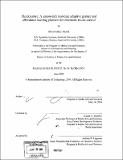FlexiGesture : a sensor-rich real-time adaptive gesture and affordance learning platform for electronic music control
Author(s)
Merrill, David Jeffrey, 1978-
DownloadFull printable version (16.44Mb)
Alternative title
Sensor-rich real-time adaptive gesture and affordance learning platform for electronic music control
Other Contributors
Massachusetts Institute of Technology. Dept. of Architecture. Program in Media Arts and Sciences.
Advisor
Joseph A. Paradiso.
Terms of use
Metadata
Show full item recordAbstract
Acoustic musical instruments have traditionally featured static mappings from input gesture to output sound, their input affordances being tied to the physics of their sound-production mechanism. More recently, the advent of digital sound synthesizers and electronic music controllers has abolished the tight coupling between input gesture and resultant sound, making an exponentially large range of input-to-output mappings possible, as well as an infinite set of possible timbres. This revolutionary change in the way sound can be produced and controlled brings with it the burden of design: Compelling and natural mappings from gesture to sound now must be created in order to create a playable electronic music instrument. The goal of this thesis is to present a device that allows flexible assignment of input gesture to output sound, so acting as a laboratory to help further understanding about the connection from gesture to sound. An embodied multi-degree-of-freedom gestural input device was constructed. The device was built to support six-degree-of-freedom inertial sensing, five isometric buttons, two digital buttons, two-axis bend sensing, isometric rotation sensing, and isotonic electric field sensing of position. Software was written to handle the incoming serial data, and to implement a trainable interface by which a user can explore the sounds possible with the device, associate a custom inertial gesture with a sound for later playback, make custom input degree-of-freedom (DOF) to effect modulation mappings, and play with the resulting configuration. A user study with 25 subjects was run to evaluate the system in terms of its engaging-ness, enjoyability, ability to inspire interest in future play and performance, (cont.) ease of gesturing and novelty. In addition to these subjective measures, implicit data was collected about the types of gesture-to-sound and input-DOF-to-effect mappings that the subjects created. Favorable and interesting results were found in the data from the study, indicating that a flexible trainable musical instrument is not only a compelling performance tool, but is a useful laboratory for understanding the connection between human gesture and sound.
Description
Thesis (S.M.)--Massachusetts Institute of Technology, School of Architecture and Planning, Program in Media Arts and Sciences, 2004. Includes bibliographical references (p. [151]-156).
Date issued
2004Department
Program in Media Arts and Sciences (Massachusetts Institute of Technology)Publisher
Massachusetts Institute of Technology
Keywords
Architecture. Program in Media Arts and Sciences.